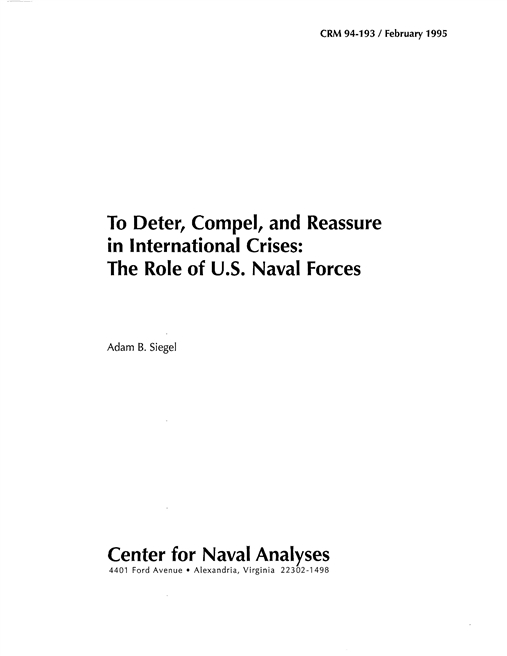With the end of the Cold War and the emergence of a new era, many of the overarching concepts behind U.S. defense policy are open to questioning. In the Cold War, deterrence was perhaps the key concept. The thinking about deterrence-both theoretical and policy related consideration-focused on nuclear deterrence issues. In the new era, deterrence remains a key issue but the focus turns to 'conventional' deterrence. Key associated concepts in this emerging new world order are compulsion and reassurance.
This paper provides some perspectives on the role of naval forces in deterrence, compulsion, and reassurance in the post-Cold War era. In addition to a brief overview of some of the theoretical issues surrounding deterrence, this paper focuses on some concrete examples of U.S. Navy and Marine Corps actions in response to or amidst inter national crises over the past 40 years. It discusses the ways these actions might have compelled an opponent to stop or reverse some action, deterred a potential adversary from taking some action, and/or reassured an ally to take some type of action. In addition to discussing naval forces, the specific case discussions outline the participation of the U.S. Army and Air Force; if they were not involved and we know the reasons they did not participate, I discuss those reasons. The discussion focuses on situations principally involving conventional forces (i.e., it does not examine U.S.-Soviet confrontations other than the Cuban missile crisis) in the hope of providing some illumination for the new security era.
This paper can only provide examples of situations in which U.S. Navy and Marine Corps operations might have played a deterrence, compulsion, or reassurance role. The theoretical discussion below discusses some of the difficulties in examining these issues. Despite such theoretical problems, it seems clear that U.S. naval forces have played a role in conventional deterrence over the past decades and will, depending on national policy decision-making, continue to do so for the indefinite future.
The following are some examples (discussed further in the paper) of where naval forces have played an important role in deterrence, com pulsion, and/or reassurance.
- Dominican Republic, 1961- Posturing by naval forces deterred the Trujillo family from attempting to reinstate a dictatorship. (Deterrence.)
- Burma, 1988- The movement of an amphibious ready group provided pressure on the military dictatorship to release Westerners held at the airport. (Compulsion.)
- Korean Peninsula, 1993-4- Amidst tensions over the North Korean program, U.S. naval (and other) forces are put on alert and moved into the area. (Deterrence and reassurance.)
APPROVED FOR PUBLIC RELEASE; DISTRIBUTION UNLIMITED.
Details
- Pages: 33
- Document Number: CRM 94-193
- Publication Date: 2/13/1995
